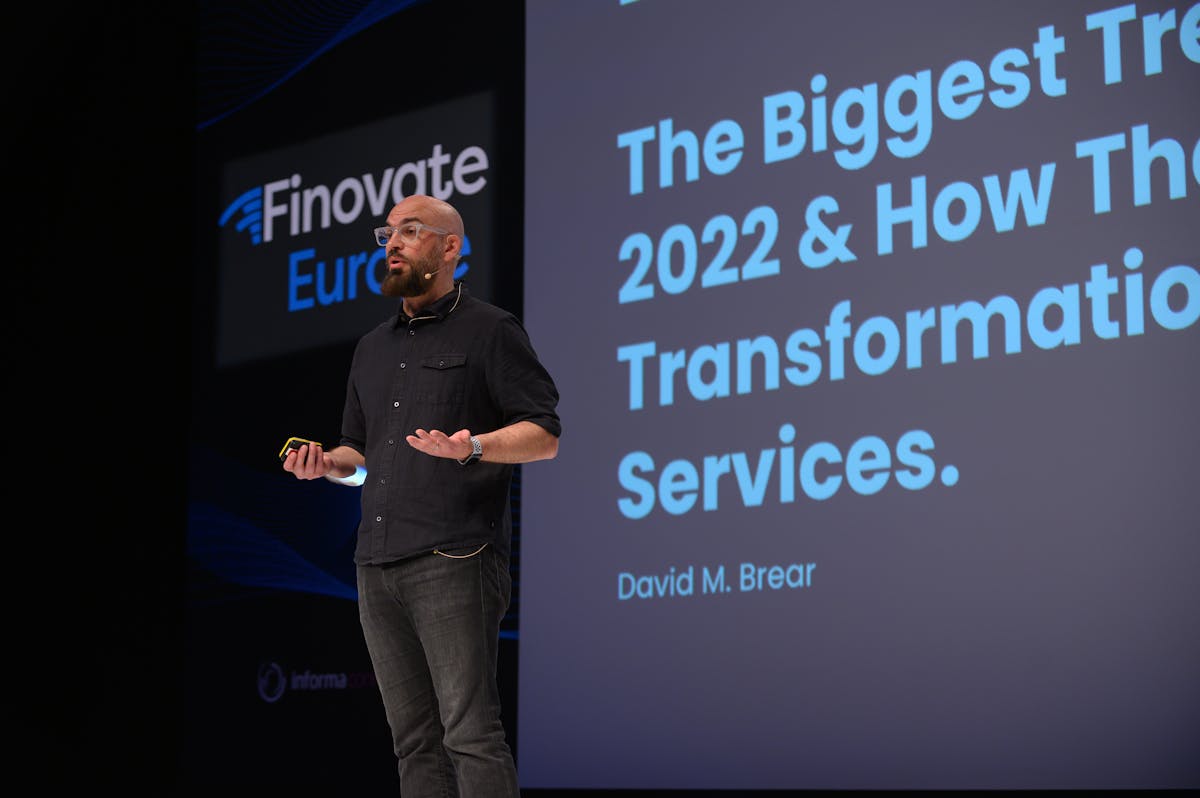Each year Finovate Europe brings together around 1,000 financial services professionals, investors, and fintech enthusiasts to celebrate the latest and greatest in the fintech world. This year’s event took place between 22–23 March at the O2 Intercontinental in London. The Meniga team was fortunate enough to attend and introduce our hyper-personalised insight management platform.
And while the opportunity to Demo is always an honour and a pleasure, Finovate Europe is also a time for us to listen, learn and gain insights into the future of banking.
Below are the three main takeaways we are walking away with from this year's Finovate.

1. Sustainability in Banking is here to stay
Sustainability in banking, Environmental, Social, and Governance (ESG), and Green Banking, were super hot topics at Finovate this year. During her keynote, Forrester's Aurelie Hostis said that "Sustainability is the new business reality. It can help firms build trust and competitive advantage.” And while some people in the industry are still evaluating how to address "Sustainability in Banking", many banks are already taking action.
A decade ago, any mention of environmentalists or climate change activists would have conjured up images of hemp necklaces and protestors chained to trees. Those days are long gone. 70% of people in 14 countries say climate change is a major threat to their country and 63% of consumers want their banks to help them track and offset their carbon footprint. Furthermore, 68% of consumers are now interested in green financial products such as green savings accounts, green loans, or green investment options.
In her Finovate recap blog, Oliwia Berdak, VP research director at Forrester, said "There’s a massive fintech opportunity around developing better technology to generate and verify environmental, social, and governance (ESG) data, drive inclusive finance (e.g. central bank digital currencies, digital identity, mobile payments), and facilitate green finance.
Although Meniga believes the most successful way for banks to enter the sustainable banking space is to engage banking customers with carbon insights, offsetting options, followed by the right product recommendation of green financial products there were some very interesting applications demoed at this year's Finovate. One great example was SESAMm which showcased the use of natural language processing (NLP) for ESG risk metrics and ended up as “Best of Show” winner.

2. Data-driven Personalisation is the key to Digital Engagement
Fintech legend David Brear of 11:FS said in his keynote address: "The future banking is the bank that Rihanna has." As in, megastar Rihanna has an army of employees that take care of her personal finances, investments, and overall financial life, whereas non-megastars like the rest of us need to manage this ourselves. Therefore, the bank that starts serving us normal joes like they are working for Rihanna, is the bank that is going to be rewarded with a lifetime of loyalty and engagement.
It's no secret that banks are not just competing with other banks. They are also up-against neo-banks like Revolut, Monzo, N26 on one side. And on the other said they face Big-Tech like Facebook Payments, Snapchat Payments, Apple, Amazon and on top of that is the battle against the thousands of fintechs - all of which are eating up their piece of the financial services cake.
Throughout the event, there was agreement that if banks are going to compete with these newcomers and if they have any intention to replace local branches that provide a smiling face and warm coffee - they would need to become personalised. A personalised 1 to 1 experience - that someone is anticipating your needs, identifying issues and offering the perfect solution just for you. Some 72% of banking customers rate personalization as “highly important” according to Capco.
One way to achieve this level of personalisation is by using artificial intelligence to analyse the bank's data lakes and pro-actively deliver personalised and helpful insights & advice to customers. Then as a next step provide the appropriate product or service that the customer needs during various milestones in his life such as getting the first job, paying rent, getting married, having children, earning more money through investments or saving for retirement. Really becoming a smart financial advisor. Or as Zil Bareisis, Head retail banking technologies at Celent said "the discovery and acquisition of tailored financial services products at the point of need" is one of the hottest topics right now.

3. Digital transformation in Banking is way behind other Industries
"When people use a banking app, they don't think of it as a banking app. They think of it as an app", said Digital pioneer & AI scientist Inma Martine. This means that when banking customers are using their banking app, they are comparing it to other apps they use every day. This means the user experience of Spotify, Google, Instagram, Facebook, Snapchat, Strava, Fitbit and all the other media leaders out there is the baseline for what good looks like. That's some pretty tough news for a lot of banks and can seem overwhelming when playing catchup on their digital channels.
According to McKinsey & Company, we have seen a whopping 23% increase in digital banking users in Europe since the start of the pandemic and today 80% of customers prefer to manage their finances digitally rather than in-person according to JP Morgan Chase. Some banks might have anticipated this incredible acceleration in the need for digital transformation but some have not.
Banking is not the only industry that is going through a transformation. Think about the video rental industry. Not so many years ago, if you wanted to rent a movie you'd head to your local Blockbusters and physically rent one. Then Netflix came along and started sending them via mail and eventually in the last few years started streaming it directly to your TV at home. Think of the music industry. Although buying vinyl has now become a trend, the CD is dead and if people want to listen to music they open up Spotify or a similar service and listen to it through a seamless user experience. Think about the car industry, we now have electrical cars replacing traditional oil-fuelled cars and self-driving cars can now drive better than most of us.
Then why is that when we open up our banking apps, so many of them feel hard to use, don't have the features we need (except for payments maybe), have no level of personalisation or human centricity at all and just generally feel like they haven't evolved since they first were launched. We won't answer that question here but if you are a bank that has that problem, please reach out to us at Meniga and we would be happy to help with your digital transformation and launching a digital experience that will drive engagement, loyalty, and revenue.

